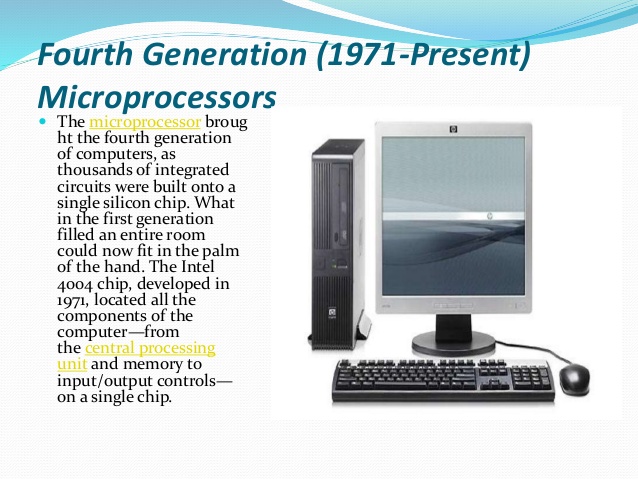Generations of computer
The
evolution of the modern computer can be viewed in specific generations which
staring from the early forties, cover 4 generations to data and we are in the
middle of the 5th generation today. Each generation was an
improvement over the formal in terms of
1. Technology è used for manufacturing the machines
2. Speed èwhich increased tremendously
3. Storage è which increased tremendously
4. Size è which reduced significantly
5. Reliability è which increased considerably
6. System cost è which decreased amount 2 ½
times.
UNVAC :- universal automatic computer.
1. 1st
generation computer (1942 to 1955)
A lot of
people in the computer would today regard the “ENIAC, EDVAC an their contemporaries as being the forerunners
of all digital computer that were
produced subsequently, and hence classify them under a ‘0’ generation category.
The 1st generation category
Features:-
1. Thermionic values and vacuum tubes are used to store the instruction.
2. The speed was limited to the mili seconds range (10-3
) -1000
3. The internal storage used primitive devices and had a
maximum capacity of 20,000
positions
4. They utilized slow input and output
5. They were extremely large and occupied a large amount of
space.
6. Need AC to run
7. Due to the large size and nature of equipment’s used their system cost and working cost was
very high.
8. They were relatively unreliable due to
frequent failure to vacuum
tubes and these generated the more heat
9. They were restricted to scientific and commercial applications.
ENIAC :- Electronic numerical integrator and
calculator
EDVAC :-
electronic discrete variable automatic computer
EDSAC :-
electronic delayed storage automatic computer
2nd
generation computer 1955 to 1964
Between end
of 50’s and 60’s there was the development of “solid-state” technology and the
invention of transistors by bell laboratories. This marked the beginning of the
2nd generation of computer.
1. Transistor
are used to store the instructions in place of vacuum tube.
2. An increase in operation speed up to the micro seconds range 10-6
3. An increase in
storage capacity accommodate as muse as 1,00,000 characters .
4. The size reduced considerably due to miniaturization of functions
5. They were a lot more reliable and the mean time between
failure [mtbf] also increased.
6. Vastly improved input/output devices such as high speed card
reader line printers and magnetic real tapes unit are use.
7. There was an overall reduction in system cost
8. Assembly languages translator – programs were used the later
stage of this generation introduced first (HLL) high level language “Fortran in
1957
Ibm 1400, imp – 7000,
3rd
generation computer 1965 – 1974
The world had moved into
3rd generation of computer development. The two outstanding characteristics
in this phase were the introduction of Integrated circuit technology (ICs) and development of
system for automotive
processing and multiprogramming
1. The electronic circuitry was based on
miniature integrated
circuits on silicon
chips which is smaller
in size, contained
the equivalent of a large number of transistor. There utilized mini processors in there internal
design.
2. The operating speed improved upto
nano seconds range (10-9)
3. Internal storage increased to a
capacity that could accommodate upto one half million characters.
4. A board range of improved
input/output devices were introduced like the micr (magnetic ink character
reader) ocr [optical character reader }
complex graphic printers and plotters etc.
5. The greater development of HLL high level
language tools place such as cobol (common business oriented language ) basic
(beginners all purpose symbolic instruction code) etc.
6. System and operating cost decreased
substantially as also did the cost of storage devises and media.
e.g. ibm system /360
4th generation 1975 up till now
around the
beginning of the last decade, a number of new computers were introduced, which
were based on LSIC technology [Large scale integrated circuits] and MOS
technology [ Metal Oxide Semi Conductor]
characteristics
of 4th generation computer
1. The technology used for their circuitry was so
specialized and miniaturized that hundreds of ICs could be etched on a chip the
size of pinhead. the use of microprocessor came into being.
2. The
operating speed improved to between the nano and pico seconds rages. 10-12
3. The internal storage capacity increased to
the range of one million positions.
4. A further
refinement of input/output devices took place
5. A further
reduction in size also occurred.
6. The
reliability increased into hundreds of hours.
7. a further refinement of HLL (high level
languages) and the introduction of special software for managing large database
occurred.
e.g. 4th
generation computer are
ibm 370 series,
apple, Pentium series I,II,III,IV,v
5th
generation computer
The fifth
generation computer are in the development stage. these computer will use ULSI[
. they will contain millions of
components on a single chip. Japan and usa have undertaken projects to design
and develop such computes. they will use
improved human – machine interface. the input and output for these machines
will be in the form of graphic images or
speeches. such machine will be able to interpret natural language (NLP natural
language processing)
intelligence
will be AI (Artificial Intelligence)
|
Acronyms
|
Full forms
|
|
IC
|
Integrated circuit
|
|
LSIC
|
Large scale Integrated circuit
|
|
VLSIC
|
Very Large scale Integrated circuit
|
|
SLSIC
|
Super Large scale Integrated circuit
|
|
ENIAC
|
Electronic Numerical Integrator and
calculator
|
|
EDSAC
|
Electronic Delayed storage automatic
computer
|
|
EDVAC
|
Electronic discrete variable automatic
computer
|
|
Univac
|
Universal automatic computer
|
|
|
|















No comments:
Post a Comment